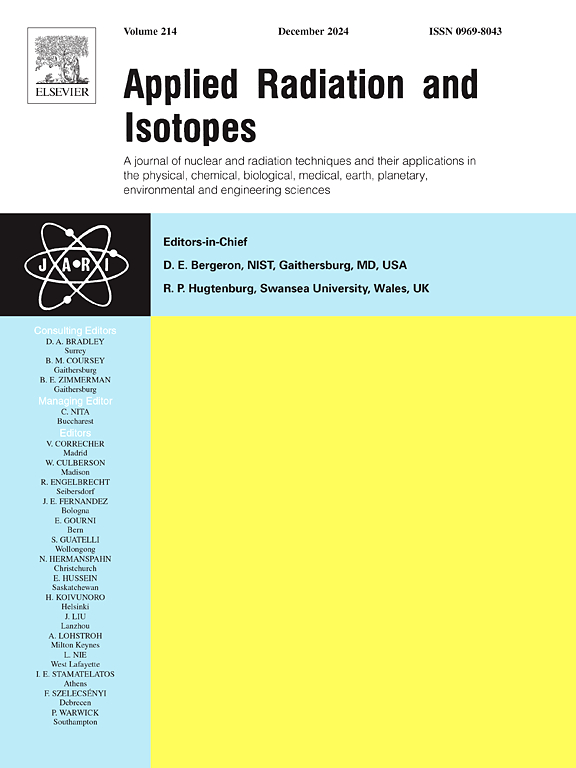DeepNSI: Element identification in experimental photoneutron spectra for illicit material detection
IF 1.8
3区 工程技术
Q3 CHEMISTRY, INORGANIC & NUCLEAR
引用次数: 0
Abstract
We present DeepNSI (Deep Neutron Spectrum Identification), a deep learning framework for identifying elemental composition from photon-induced neutron spectra in realistic inspection scenarios. Targeted toward the detection of illicit materials, DeepNSI consists of an ensemble of element-specific convolutional neural networks trained on a hybrid dataset of simulated and experimental photoneutron spectra. Special emphasis is placed on detecting light elements such as nitrogen and oxygen, which are key signatures of explosives and chemical threats. The model incorporates Monte Carlo Dropout to provide predictive uncertainty and employs a post-processing step based on non-negative least squares (NNLS) to reconstruct the experimental spectrum from reference components. Evaluation on real data—including organic compounds and complex configurations involving shielding materials—demonstrates robust element identification, with uncertainty estimates supporting decision confidence. Although NNLS coefficients are influenced by nuclear cross sections and cannot be interpreted as direct concentrations, their trends across samples reflect meaningful compositional differences. These results establish DeepNSI as a reliable tool for interpretable, machine-learning-based elemental analysis in photon interrogation systems coupled with photoneutron spectrometry.
DeepNSI:用于非法物质检测的实验光子中子光谱中的元素识别
我们提出了DeepNSI(深度中子谱识别),这是一个深度学习框架,用于在现实检测场景中从光子诱导的中子谱中识别元素组成。针对非法材料的检测,DeepNSI由一系列特定元素的卷积神经网络组成,这些神经网络是在模拟和实验光子中子光谱的混合数据集上训练的。特别强调的是探测轻元素,如氮和氧,这是爆炸物和化学威胁的关键标志。该模型采用蒙特卡罗Dropout来提供预测不确定性,并采用基于非负最小二乘(NNLS)的后处理步骤从参考分量中重建实验光谱。对真实数据(包括有机化合物和涉及屏蔽材料的复杂结构)的评估显示了稳健的元素识别,不确定性估计支持决策置信度。虽然NNLS系数受到核截面的影响,不能直接解释为浓度,但它们在样品间的趋势反映了有意义的成分差异。这些结果确立了DeepNSI作为可解释的、基于机器学习的元素分析的可靠工具,可以在光子询问系统中与光子中子光谱相结合。
本文章由计算机程序翻译,如有差异,请以英文原文为准。
求助全文
约1分钟内获得全文
求助全文
来源期刊

Applied Radiation and Isotopes
工程技术-核科学技术
CiteScore
3.00
自引率
12.50%
发文量
406
审稿时长
13.5 months
期刊介绍:
Applied Radiation and Isotopes provides a high quality medium for the publication of substantial, original and scientific and technological papers on the development and peaceful application of nuclear, radiation and radionuclide techniques in chemistry, physics, biochemistry, biology, medicine, security, engineering and in the earth, planetary and environmental sciences, all including dosimetry. Nuclear techniques are defined in the broadest sense and both experimental and theoretical papers are welcome. They include the development and use of α- and β-particles, X-rays and γ-rays, neutrons and other nuclear particles and radiations from all sources, including radionuclides, synchrotron sources, cyclotrons and reactors and from the natural environment.
The journal aims to publish papers with significance to an international audience, containing substantial novelty and scientific impact. The Editors reserve the rights to reject, with or without external review, papers that do not meet these criteria.
Papers dealing with radiation processing, i.e., where radiation is used to bring about a biological, chemical or physical change in a material, should be directed to our sister journal Radiation Physics and Chemistry.
 求助内容:
求助内容: 应助结果提醒方式:
应助结果提醒方式:


